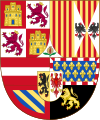Coat of arms of the King of Spain
| Coat of arms of the King of Spain | |
|---|---|
 | |
| Armiger | Felipe VI |
| Adopted | 19 June 2014 |
| Crest | Spanish Royal Crown |
| Shield | Quarterly: Castile, León, Aragon, and Navarre; enté en point: Granada; inescutcheon Bourbon (Anjou Branch) |
| Order(s) | Order of the Golden Fleece |
| Earlier version(s) | See below |
The coat of arms of the King of Spain is the heraldic symbol representing the monarch of Spain. The current version of the monarch's coat of arms was adopted in 2014 but is of much older origin. The arms marshal the arms of the former monarchs of Castile, León, Aragon, and Navarre.
Traditionally, coats of arms did not belong to a nation but to the monarch who would quarter his shield with territorial claims of his dynasty. Formerly, the Spanish monarch's arms were much more complex than they are today, featuring the arms of the various territories of this dynasty. A simpler version of these arms, known as the lesser arms, was also used; The lesser arms were another set of arms within the centre of the full arms. During the later part of the Bourbon dynasty, this was quarterly Castile and León.
In 1868, during the provisional government that followed the overthrow of Queen Isabella II, an arms of national character was adopted; This 1868 arms created the present-day arrangement of elements in the shield. The "national arms" and "royal arms" coexisted after the restoration of the monarchy. In 1931, the "national arms" were revised into the royal arms, replacing the former lesser arms of the King (i.e. quarterly Castile and León). The monarchy was abolished later that year.
When Juan Carlos, grandson of Alfonso XIII (the last king of Spain), was chosen to be the successor of General Francisco Franco, the arms adopted for his use in 1971 as Prince of Spain was quarterly Castile, Leon, Aragon, and Navarre. The heraldic achievement also included the collar of the Order of the Golden Fleece, the Cross of Burgundy and the yoke and bundle of arrows formerly used by the Catholic Monarchs, the same arms he would use as King. Upon Felipe VI's ascension to the throne in 2014, the cross, yoke, and arrows were dropped from the royal arms.
Blazon
The blazoning of the coat of arms of the King of Spain is set out in Royal Decree 527/2014, 20 June, an amendment to Title II of Spanish Royal Decree 1511/1977 adopting Flags, Standards, Guidons, Insignia and Emblems Regulation.[1] The coat of arms was adopted when King Felipe VI was enthroned as King of Spain.[2]
The shield is divided into four-quarters, blazoned as follows:
- 1st, gules a castle or, triple-embattled and voided gate and windows, with three towers each triple-turreted, of the field, masoned sable and ajoure azure, which is for Castile;
- 2nd, argent a lion rampant purpure crowned or, langued and armed, of the second, which is for León;
- 3rd, or, four pallets gules, which is for Aragon;
- 4th, gules a cross, saltire and orle of chains linked together or, a centre point vert, which is for Navarre;
Argent enté en point, with a pomegranate proper seeded gules, supported, sculpted and leafed in two leaves vert, which is for Granada.
Inescutcheon azure bordure gules, three fleurs-de-lys or, which is for Bourbon-Anjou. This is not an inescutcheon of pretence, but one in use by monarchs and states, in this case the Spanish Royal Family to show their descent from the French House of Bourbon through the Anjou line.
All surrounded by the collar of the Golden Fleece and crowned with a crown of the same metal and precious stones, with eight rosettes, five visible, and eight pearls interspersed, closed at the top by eight diadems also adorned with pearls and surmounted by a cross on a globe, which is the royal crown of Spain.[3]
In 1969, General Francisco Franco appointed Juan Carlos I as his "successor to the Headship of the Spanish state with the title of King" but gave him the new title of Prince of Spain instead of the traditional title of Prince of Asturias. From 1971 to 1975, Juan Carlos as Prince of Spain used a coat of arms which was virtually identical to the one later adopted when he became King in 1975. Earlier coat of arms differed only that it featured the royal crown of a Crown Prince of Spain, the King's royal crown has eight half-arches of which five are visible, while the Prince's one has only four half-arches of which three are visible.[4] Joined to the shield was the red saltire of Burgundy and, to the dexter and sinister of the base point, the yoke gules in its natural position with ribbons, of the field, and the sheaf of five arrows gules with the arrowheads inverted and ribbons, of the field, which used to be the symbol of the Catholic Monarchs of Spain.
The cross of Burgundy, the yoke and arrows had not been used by any Spanish monarch since the Catholic Monarchs and were added to symbolize the Movimiento Nacional.[5]
Since June 2014, Juan Carlos's son, Felipe VI, has been using the same arms but without the cross of Burgundy, yoke and arrows.[6] King Juan Carlos's arms include a red lion instead of the purple one displayed on the current version[7]
Variants
| Variants of the coat of arms of the King of Spain | |||
|---|---|---|---|
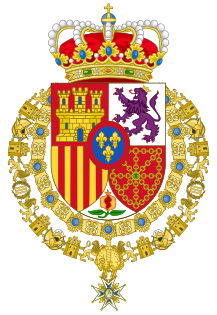 |
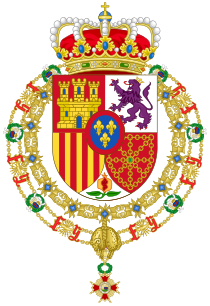 |
 |
 |
| Variant as Grand Master of the Order of Charles III Surrounded by the collar of this order |
Variant as Grand Master of the Order of Isabella the Catholic Surrounded by the collar of this order |
Variant as Grand Master of the Order of Saint Ferdinand Surrounded by the grand master's collar |
Variant as Grand Master of the Order of Saint Hermenegild Surrounded by the grand master's collar of this order |
Ornamented versions of the historical royal coats of arms
| Royal Arms | Monarch | Supporters | Other ornaments | Motto |
|---|---|---|---|---|
| House of Trastámara (1475–1506) | ||||
 |
The Catholic Monarchs |
|
|
|
 |
The Catholic Monarchs |
|
|
Tanto monta |
 |
Ferdinand II of Aragon |
|
||
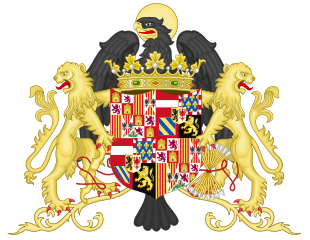 |
Joanna of Castile |
|
|
|
 |
Philip I of Castile |
|
|
Qui voudra |
| House of Habsburg (1506–1700) | ||||
 |
Charles I |
|
|
Plus oultre |
 |
Charles I |
|
|
Plus ultra |
 |
Charles I |
|
|
Plus ultra |
 |
Philip II |
|
|
Honi soit qui mal y pense |

|
Philip II |
|
|
|
| House of Bourbon (1700–1808 / 1813–1868 / 1874–1931 / 1975–present) | ||||
 |
Philip V |
|
|
|
 |
Charles III |
|
|
|
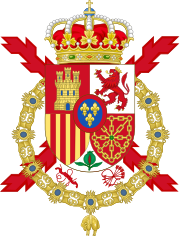 |
Juan Carlos I |
|
||
| French occupation (1808–1813) | ||||
 |
Joseph Bonaparte |
|
|
|
| House of Savoy (1870–1873) | ||||
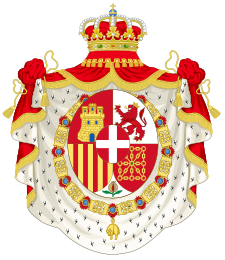 |
Amadeus |
|
||
Royal family
Arms of Members of the Royal Family, their spouses & children.
| Armorial achievement | Bearer |
|---|---|

|
Personal Arms of Letizia, Queen of Spain
|

|
Personal Arms of Sofia, Queen of Spain
|

|
|

|
Personal Arms of Infanta Elena, Duchess of Lugo
|

|
Personal Arms of Don Felipe de Marichalar y Borbón
|

|
Personal Arms of Dona Victoria de Marichalar y Borbón
|

|
Personal Arms of Infanta Cristina
|

|
Personal Arms of Don Juan Urdangarin y Borbón
|

|
Personal Arms of Don Pablo Nicolás Urdangarin y Borbón
|

|
Personal Arms of Don Miguel Urdangarin y Borbón
|

|
Personal Arms of Dona Irene Urdangarin y Borbón
|

|
Personal Arms of Infanta Margarita, Duchess of Soria and Hernani
|

|
Personal Arms of Carlos Zurita, Duke of Soria
|

|
Personal Arms of Don Alfonso Carlos Zurita y Borbón
|

|
Personal Arms of Dona María Zurita y Borbón
|
See also
- Coat of arms of Charles V, Holy Roman Emperor
- Armorial of Spanish monarchs in Italy
- Coat of arms of the Prince of Asturias
- Coat of arms of the Prince of Spain
- Royal Standard of Spain
References
- ^ "Real Decreto 527/2014, de 20 de junio, por el que se crea el Guión y el Estandarte de Su Majestad el Rey Felipe VI y se modifica el Reglamento de Banderas y Estandartes, Guiones, Insignias y Distintivos, aprobado por Real Decreto 1511/1977, de 21 de enero" [Royal Decree 527/2014 setting up the Guidon and Standard of HM King Felipe VI and amends Standards, Guidons, Insignia and Emblems Regulation, adopted on Royal Decree 1511/1977] (PDF). BOE Spanish Official Journal (in Spanish). 20 June 2014. Retrieved 21 June 2014.
- ^ "Felipe VI ya cuenta con escudo y guión propios" [Felipe VI has his own coat of arms and guidon]. heraldo.es (in Spanish). 19 June 2014. Retrieved 20 June 2014.
- ^ Coat of arms of His Majesty the King of Spain. The Royal Household of the King of Spain. Retrieved 19 October 2011.
- ^ (in Spanish) Spanish Decree 814 of 22nd April 1971. Boletín Oficial del Estado, Official Gazette of the Spanish Government, no. 99. Retrieved 19 October 2011.
- ^ (in Spanish) Spanish Decree 814 of 26th of April 1971 Boletín Oficial del Estado, Official Gazette of the Spanish Government, no. 99. Retrieved 23 October 2024.
- ^ "Coat of arms of His Majesty King Juan Carlos". Spanish Royal Household Website. 19 June 2014. Retrieved 20 June 2014.
- ^ "Coat of arms of His Majesty the King". Spanish Royal Household Website. 19 June 2014. Retrieved 20 June 2014.
